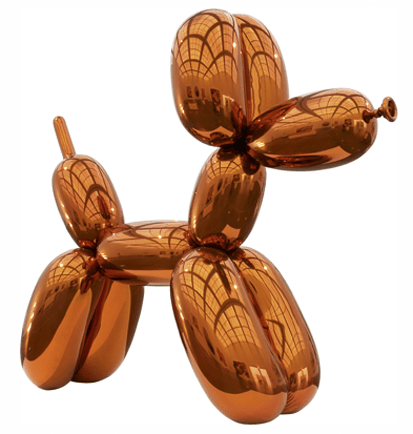The contrast could not have been more acute. It came the day after a press release from Christie’s New York pinged into my inbox announcing the forthcoming sale of Jeff Koons’s ‘Balloon Dog (Orange)’ on 12 November. Even by current auction-house standards, the hype was of heroic immoderation but it was the novel brazen pandering that shocked me.
It is a moot point whether Mr Koons’s monumental party balloon — sleekly engineered in high chromium stainless steel and more than three metres long and some three and a half metres high — is indeed ‘the most beloved of all contemporary sculptures’, or whether the auction itself will be a ‘landmark’ event ‘set to make history’. It is presented almost as a foregone conclusion that the sculpture, bearing an estimate of $35 million to $55 million, will eclipse not only the artist’s current auction record but also that set at Sotheby’s in May by Gerhard Richter’s ‘Domplatz, Mailand’ — $37.1 million — to become the most expensive work by a living artist ever sold at auction.
‘Balloon Dog (Orange)’ can, of course, be described quite legitimately as ‘a Pop icon of our age’. Koons’s sculptures, not least the gleaming oversize trophies in his Celebration series, are a perfect reflection — and indictment — of our appearance-obsessed and infantilised age. Their ‘wow’ is one of instant gratification, a response dependent on immediate, pleasurable recognition, unexpected scale, a perfection of surface and exuberant colour. By their very nature, they are banal and superficial.
According to Christie’s usually sensible and estimable Brett Gorvy, ‘Balloon Dog’ is nothing short of ‘the Holy Grail for collectors and foundations’. Then he continues: ‘In private hands, the work has always communicated the prominence and stature of its owner…To own this work immediately positions the buyer alongside the very top collectors in the world and transforms a collection to an unparalleled level of greatness.’ Really?
The five differently coloured ‘unique versions’ (we’ll let that one pass) of the work, we are informed, are owned by ‘the world’s greatest and most revered private collectors’ (or their foundations) — Eli Broad, Steve Cohen, Dakis Joannou, François Pinault, who owns Christie’s, and Peter Brandt, the consignor of this one. Just in case any billionaire out there does not get the point, the auction house is suggesting that ‘Balloon Dog (Orange)’ will buy you status and kudos. A more cynical view would be that all any buyer will really demonstrate is his or her ability to pop $40 million or so on a blue-chip work of art. Those early prescient collectors are believed to have paid between $2 million and $6 million for theirs.
The whole release gives the impression that potential buyers are being led by the nose not only to buy ‘Balloon Dog’ but also to pay more for it than anyone has ever spent on a piece of contemporary art. At the end of the phenomenally successful series of contemporary art sales in New York in May, after Christie’s totalled a record $640 million in a single week, a statement hailed ‘a new era in the art market, wherein seasoned collectors and new bidders compete at the highest level of the market’. One suspects that it is naïve, novice buyers from across the globe that the auction house has its eye on, but is it wise to pump up a market already as spectacularly inflated as Koons’s balloon dog?
It was works of art, rather than buyers, from across the globe that took me to Paris the next day for Parcours des Mondes (10–15 September). Paris remains the centre of the growing but still dealer-dominated tribal art market, and this initiative, now in its 12th year, sees the collaboration of the specialists situated around Saint-Germain-des-Prés, plus invited international colleagues. The modest overheads of this ‘open house’ gallery format allow the participation of dealers who do not necessarily sell expensive pieces, but all exhibits are vetted. Some 60 galleries put on a show, and it was pure joy.
The pleasure derived not only from the at times exceptional quality and interest of the exhibits but also from the intimacy of the spaces and the engagement they allowed with both the works of art and those who dealt in them. For these dealers — the ones I met, at least — were passionate and knowledgable. Dipping in and out of the galleries prompted revelations and mini master-classes in equal number — from the otherworldly paintings produced by the indigenous Warli of India (Galerie Frédéric Moisan; prices from €300) to the aggressive animal iconography of the headhunting Asmats of New Guinea (Michel Thieme; €2,000–70,000). There were costly museum-quality rarities — indeed a compelling Okvik ivory fertility figure carved in Alaska around 200 BC–100 AD presented by Donald Ellis was reserved by an American museum — but what appeals about this or any other niche market is that a great piece does not have to be bankrupting. There are no short cuts to working out which those great pieces might be but the buyers here, collectors rather than investors, are in no hurry.






Comments